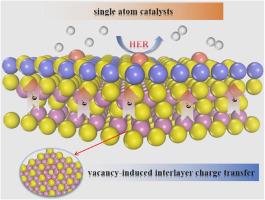通过表面空位和层间电荷转移提高znin2s4基单原子催化剂析氢反应性能
IF 8.3
2区 工程技术
Q1 CHEMISTRY, PHYSICAL
引用次数: 0
摘要
开发用于析氢反应的高效单原子催化剂对于推进清洁能源技术的发展至关重要。在本研究中,我们利用第一性原理计算方法研究了表面空位对ZnIn2S4单层膜HER性能的影响。我们的研究结果表明,引入硫空位(Sv)和铟空位(Inv)触发层间电荷转移,导致金属原子周围的电荷重新分布,并改变了znin2s4基sac的催化行为。值得注意的是,Pt/ZnIn2S4表现出出色的HER活性,ΔGH *为0.02 eV,与实验报告非常一致。此外,Ir/ZnIn2S4-Sv和Ir/ZnIn2S4-Inv也表现出优异的催化性能,ΔGH∗为0 eV,表明它们有潜力成为高效的HER SACs。该研究强调了层间电荷转移在调节催化活性中的关键作用,并为设计新型高效的sac以实现可持续制氢提供了有价值的见解。本文章由计算机程序翻译,如有差异,请以英文原文为准。

Enhancing hydrogen evolution reaction performance of ZnIn2S4-Based single atom catalysts via surface vacancies and interlayer charge transfer
The development of efficient single atom catalysts (SACs) for the hydrogen evolution reaction (HER) is crucial for advancing clean energy technologies. In this study, we investigate the effects of surface vacancies on the HER performance of ZnIn2S4 monolayers using first-principles calculations. Our findings show that introducing sulfur vacancies (Sv) and indium vacancies (Inv) triggers interlayer charge transfer, resulting in charge redistribution around metal atoms and modifying the catalytic behavior of ZnIn2S4-based SACs. Notably, Pt/ZnIn2S4 exhibited outstanding HER activity with a ΔGH∗ of 0.02 eV, in excellent agreement with experimental reports. Furthermore, Ir/ZnIn2S4-Sv and Ir/ZnIn2S4-Inv also demonstrated superior catalytic performance with a ΔGH∗ of 0 eV, indicating their potential as highly effective HER SACs. This study underscores the crucial role of interlayer charge transfer in modulating catalytic activity and offers valuable insights for the design of novel and efficient SACs for sustainable hydrogen production.
求助全文
通过发布文献求助,成功后即可免费获取论文全文。
去求助
来源期刊

International Journal of Hydrogen Energy
工程技术-环境科学
CiteScore
13.50
自引率
25.00%
发文量
3502
审稿时长
60 days
期刊介绍:
The objective of the International Journal of Hydrogen Energy is to facilitate the exchange of new ideas, technological advancements, and research findings in the field of Hydrogen Energy among scientists and engineers worldwide. This journal showcases original research, both analytical and experimental, covering various aspects of Hydrogen Energy. These include production, storage, transmission, utilization, enabling technologies, environmental impact, economic considerations, and global perspectives on hydrogen and its carriers such as NH3, CH4, alcohols, etc.
The utilization aspect encompasses various methods such as thermochemical (combustion), photochemical, electrochemical (fuel cells), and nuclear conversion of hydrogen, hydrogen isotopes, and hydrogen carriers into thermal, mechanical, and electrical energies. The applications of these energies can be found in transportation (including aerospace), industrial, commercial, and residential sectors.
 求助内容:
求助内容: 应助结果提醒方式:
应助结果提醒方式:


